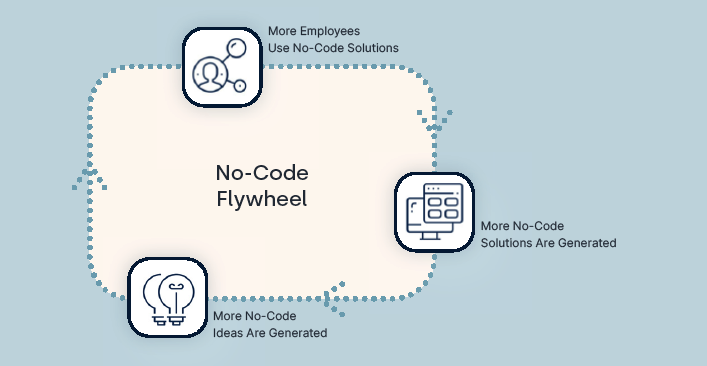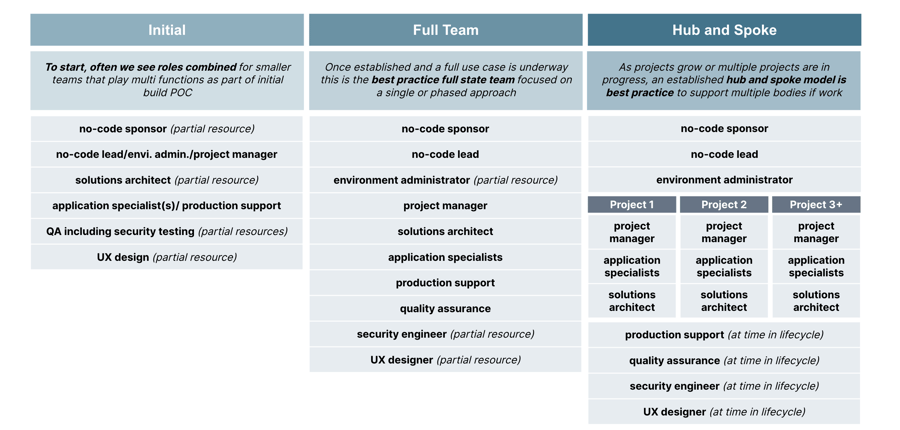Introduction
To remain competitive in today’s fast-moving marketplace, business leaders must ensure their organizations are always at the technological forefront. This means:
-
Automating at scale complex processes that previously relied on human intermediation
-
Addressing rising user expectations for digital-first experiences
-
Overcoming market disruptions of all shapes and sizes
-
And doing it faster than the competition
To keep up with the increasing demand to “go digital,” technology leaders are turning to new development methods, such as enterprise no-code application platforms. In a no-code application platform, enterprise software is built and maintained through a visual UI instead of writing out complex lines of code. All key application components (e.g., front-end elements, back-end processes, and third-party integrations) are represented as configurable drag-and-drop components which can define workflows visually. The platform executes these graphic representations of commands as if they were written in code, and the codebase is automatically generated and updated by the platform based on visual input from the user.
By streamlining development organizations are empowered to build complex software 3x faster using 3x fewer resources, and with 600x fewer bugs than traditional code/low-code-based approaches. As a result, organizations are able to rapidly move around disruptions of any scale.
In order to realize the true potential of no-code, it must be viewed as an organization-wide endeavor. To apply this new development paradigm effectively at scale, organizations need to take a systematic approach organized through a No-Code Center of Excellence (CoE). In this eBook, we will explore how organizations should approach building and optimizing their No-Code CoE.
"You want to pick a platform to backbone your [Center of Excellence] program that you can develop, deploy, and iterate on quickly. And what better option than the first no-code platform, Unqork?"
—Evan Rosen, Senior Architect, Persistent Systems
What is a No-Code CoE?
A No-Code CoE is an internal team focused on promoting and nurturing no-code throughout the organization. This team achieves this by defining best practices, implementing them at scale, and providing ongoing support to all no-code projects. These efforts are best organized through a People, Process, and Technology (PPT) framework:
People
The No-Code CoE provides a core structure that oversees how no-code is integrated throughout the organizations. It dictates the roles and responsibilities for team members supporting a no-code initiative. (See “What Does the No-Code CoE Look Like?” section below.)
Process
CoEs must establish guidelines and best practices for how no-code is applied throughout the organization. This includes, but is not limited to, compliance regulations, information security requirements, and all regulatory standards. The CoE is responsible for continuously identifying—and addressing—areas for improvement throughout the Software Development Lifecycle (SDLC). (Read the “No-Code CoE Activities” section below for more information on these activities.)
Technology
CoEs must choose the best technologies to support their no-code efforts. This all begins with the choice of a no-code application platform, but also includes the choice of third-party services that will be integrated for specific solutions, as well as collaboration/productivity software used to organize key CoE activities.
What does a No-Code CoE look like?
Individual projects will tap specific internal or external talent to achieve their goals, but the No-Code CoE will maintain a consistent core of colleagues who will manage the development and implementation. An effective No-Code CoE will need to fill the following critical roles for each project:
- No-code sponsor: Board member or C-level role who comes with a familiarity of the organization as a whole and is responsible for ensuring that the CoE is established as a priority enterprise-wide
- No-code lead: This is a senior executive, accountable for the CoE activities, performance reporting, and operational leads
- Environment administrator: This is an overarching role that structures and manages workspaces including Applications, Express/Creator Permissions etc.
- Project manager/Product owner: This is the day-to-day lead in charge of ensuring that the business’ needs are being addressed and the resulting outcomes. He/she is going to be directing the team and making sure the path is clear for all involved. He/she is also responsible for providing requirements.
- Solutions architect: This is the technical lead who is in charge of quality and build and oversees the project from a technical standpoint (recommended: technical background, but understands the importance of business goals)
- Application specialists/Production support: These are the team members directly engaging with the no-code platform who will configure and work with the platform to create a final product, however once the application is launched in Production, it’s common to have this role migrate to Production Support as the first level of application and configuration support (recommended: fundamentals of Java and Javascript)
- Quality assurance: This role is charged with ensuring that the product meets the needs of the business and end-user and is responsible for testing all team builds and establishing an iterative testing plan (recommended: experience with manual and automated testing)
- Security engineer: This role determines the security and privacy requirements of an application and provides guidance and threat modeling, utilizes Dynamic Application Security Tests (DAST) and/or penetration tests.
- UX designer/Engineer: This role designs as part of the planning phase and finalizes it via usability testing. The Engineer role then implements the design.

Once the principles of your CoE have been noted, you need to decide on how best to scale your No-Code CoE across your organization—that is, to take a Centralized, Decentralized, or Hybrid approach.
-
Centralized: In the centralized approach, all CoE functionalities are driven by one core team. The central CoE provides expertise and manages the common resources required to deliver no-code successfully throughout the organization.
The processes pipeline is handled by a single team that distributes no-code development and management functionalities across the organization. The centralized model is very scalable as there is one contact point for the entire initiative, but can be slower to react and can be the source of bottlenecks as it begins to address the needs of more teams.
-
Decentralized: The decentralized (or “federated”) CoE model spreads its capabilities across the organization into separate business units (BUs). Each BU will have its own capabilities for prioritization, assessment, and development of no-code. This model is loosely governed, and different lines of business establish their own CoE guidelines and structures. This may allow certain teams to implement no-code faster and tailor it to their needs, but it will be more difficult to scale or standardize across the organization. Note: If you start out with a decentralized model, it will take significant effort to move over to a scalable hybrid or centralized model.
-
Hybrid: There are pros and cons for both decentralized and centralized models, which is why many organizations opt for a hybrid of the two approaches. In this method, a well-established centralized No-Code CoE can provide operations and delivery support, while the BUs have their own capabilities for prioritization, assessment, development, and maintenance. The hybrid model will have the scalability of the centralized model without the limitations of distribution.
No-Code CoE activities
The No-Code CoE is responsible for identifying areas for no-code will be applied, managing the queue of projects, and overseeing the entire Software Development Lifecycle (SDLC). In order to scale and expand no-code functionality across an organization, there are five primary areas the No-Code CoE oversees:
Discover
The No-Code CoE is responsible for identifying and prioritizing no-code projects. Initially, the CoE may independently identify “low-hanging fruit” most ripe for no-code transformation (e.g., critical workflows that are overly reliant on manual tasks).
- Click here for more on choosing an initial no-code project
Once the speed and impact of no-code is demonstrated, CoEs should anticipate increased demand for no-code across the organization. The CoE will need to manage and prioritize the no-code transformation and innovation pipeline.

Here are some key steps the No-Code CoE will need to take in order to structure, manage, and—when demand necessitates—automate the processing of ideas submitted from throughout the organization:
-
Idea submission: Develop a custom idea-submission flow that aligns ideas to business KPIs. Apply submissions to specific business themes and anticipate questions that can be posed to idea-owners to properly categorize their idea.
-
Idea refinement: Manage the process of feedback/iteration between idea-owners and the CoE in order to precisely identify objectives and requirements.
-
Idea evaluation: Determine project prioritization via standardized evaluation criteria.
-
Idea management: Manage the entire pipeline of ideas across all stages with dashboards that provide real-time visibility into project progress.
Roles involved: no-code sponsor, environment administrator, UX designer, solutions architect
Build
The Build phase is when the CoE begins creating the application on a no-code platform and transforming a business idea into a solution. Here are some of the elements that will have to be addressed during this phase:
-
Planning & design: A key early part of the build process is gathering requirements from all parties on a project’s high-level requirements (e.g., business, security, or potentially even users) and anticipating which elements and resources will be needed to bring the project to reality.
-
User journey: The CoE is responsible for defining how users interact with business systems. Furthermore, since no-code makes it easy to build high-fidelity prototypes, alpha/beta testers can provide feedback early in the process, which can guide iterations towards a truly user-centered experience.
-
Business logic: CoEs are responsible for automating complex processes at scale with cross-functional workflows triggered by events in real-time. Since these tasks are handled completely visually in a no-code platform, this process doesn’t necessarily rely on experienced developers and can be handled by business users or less-experienced teammates.
-
Data management: No-code makes it easy to push and pull data throughout your digital ecosystem. Indeed, Unqork’s schema-free environment allows you to build without explicitly defined data models. CoEs are responsible for building a system that can extract, transform, and load data from multiple sources.
-
APIs & integrations: No enterprise solution lives in a vacuum. CoEs are responsible for connecting any new custom application to legacy systems and third-party solutions.
Roles involved: project manager, environment administrator, application specialists, UX designer, solutions architect
Analyze and optimize
In particular, the CoE should systematically quantify and track:
- The relevant impact of each solution (e.g., increase in process efficiencies, rise in user satisfaction, speed-to-resolution)
- The resources required to develop them, which can be directly compared to the resources that would be needed to achieve that same outcome using a traditional code-based approach. This data-gathering will allow the CoE to prove the value of no-code and expand its scope throughout the organization.
Using the data and measurement, CoE’s should also consider where to Optimize through additions or edits and fold that into next areas of focus for the team.
Roles involved: no-code sponsor lead, project manager
Manage
During this phase, the CoE will oversee and administer crucial application elements related to security, personnel, and production. This area includes:
-
Identity management: Authenticate end-users using your systems. Unqork integrates with your active directory to support OIDC, SAML 2.0, 2FA, or custom single sign-on (SSO).
-
Access control: Define which roles or individuals have access to which parts of your system. Unqork, for example, provides robust RBAC functionality to control access at a granular level.
-
Security & compliance: Ensure your system is meeting best practices for security
-
Review, test, release, support: In the review phase, the CoE is responsible for removing errors in the application to ensure software meets your quality standards. Once an application passes through QA, it’s ready to release into the world—first through deployment into a testing environment and then into production with your production support resource supporting.
Roles involved: quality assurance, security engineer, project manager, production support

“North stars” for your No-Code CoE
Drive innovation
To remain competitive in today’s fast-moving and increasingly competitive marketplace, organizations must ensure that they are at the technological forefront. No-Code empowers companies to build enterprise-ready software 3x faster and using 3x few resources than a traditional code/low-code-based approach, which completely changes how organizations frame the cost/benefit analysis of experimentation and innovation.
Coded solutions have high fixed costs to begin with, budget limitations have traditionally dictated that only the projects with an obvious value-add end up moving forward. This makes sense within the constraints of traditional application development, however it means that the boldest ideas may never see the light of day.
Experimentation, however, is where competitive advantages are taken or secured. Consider how large technology companies like Alphabet and Facebook are constantly deploying new digital products and functionality—some prove to be successful, others are simply abandoned. Experimentation allows these titans to maintain their position in a fast-moving marketplace.
Unfortunately, most companies probably aren’t in a position where they can allocate massive amounts of resources into developing projects where the result is less than certain—at least, not when using a traditional code-based approach. With no-code, companies are able to mitigate the risk of development, and build-out the capacity to experiment with addressing business problems in novel ways.
Improve digital resilience
Digital resilience means having the technological and organizational muscle to adapt to whatever marketplace disruptions of any scale, be they a new competitive offering, a regulatory change, or something as big as a global pandemic. Since no-code removes many of the common friction points of development, organizations are able to rapidly adjust their digital infrastructure to address changes of all sizes. Digital resilience is an increasingly important competitive differentiator and the No-Code CoE is responsible for driving this functionality.
Embrace user-centricity
With no-code, organizations to rapidly iterate user-facing engagements based on feedback or to keep-up with new competitive offerings. The No-Code CoE will manage customer feedback and measure user behavior and satisfaction to ensure that your organization is always offering streamlined, high-quality engagements that deliver personalized service at scale and 24/7 access to information and services.
Scale-out to the entire organization
Since no-code is far more intuitive than traditional code-based approaches, many parts of development can be handled by users who lack traditional coding/development backgrounds. No-Code CoEs can take advantage of this new paradigm and empower business users to directly apply their experience and expertise without relying on the intermediation of others.
Final Thoughts
A No-Code CoE can help an organization optimize internal processes, amplify employee productivity, and enhance the user experience. With a No-Code CoE, organizations can rapidly build and effectively manage highly automated workflows and complex processes across the entirety of its digital ecosystem. Want to learn more about how to begin your no-code journey? Schedule a personalized demo with one of our no-code experts today.



